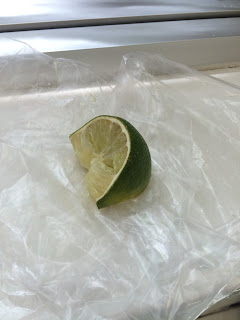About a week ago I planted some red lettuce seeds and have seen great progress so far. I planted the seeds in small, rock wool grow-cubes. They are specially designed to maximize the growth of seedlings. This is because of the tiny air pockets and sponge-like qualities of the cubes. Here are some photos of the process.
These are the grow cubes sitting in the propagation tray where they will remain until transplant. Prior to adding the seeds, I soaked the cubes in Ph6 water to optimize the acidity of the growing environment. I made sure to soak the cubes for extra long because I was going out of town for a week after planting these seeds.
Pictured above are is a slice of lime and a pH test kit. I used the lime to bring down the acidity of the solution that the cubes sat in. As you can see by the picture on the right, the pH was about 6. The test kit works by filling the tube about halfway with the solution you are testing and adding two to three drops of the testing liquid. The more acidic the solution, the more red it appears after adding the testing liquid. If the solution is highly basic, it will have a blue appearance.
Pictured above are two seeds in a grow cube. I typically plant to or three in each because not all will turn out right. When I transplant the cubes into netted cups with hydration, I will remove the "weakest"/ less desirable plant.
This is a picture of the cubs 6 days after plating. The plants appear to be "stretching", which means they are not getting enough light. Since I am unable to get artificial light into this location and lettuce needs relatively little light, I am not too worried. The maroon-ish base the cubes are sitting on allows the roots to grow through the "net"on the bottom. This prevents the roots from growing flat against the cube.









